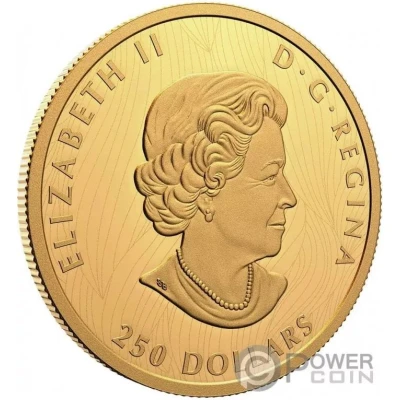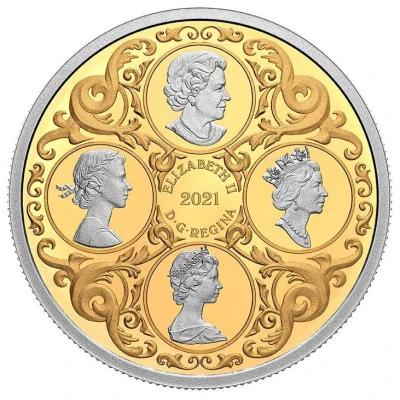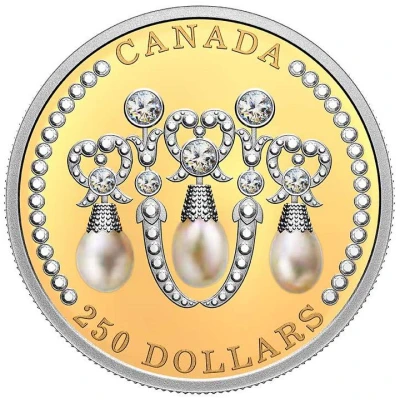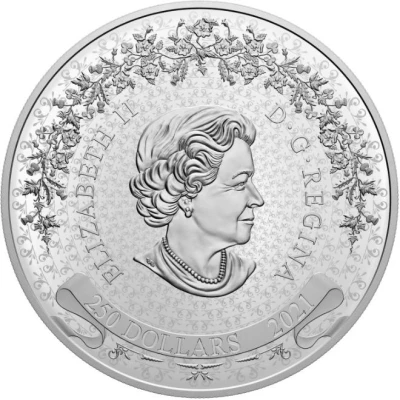
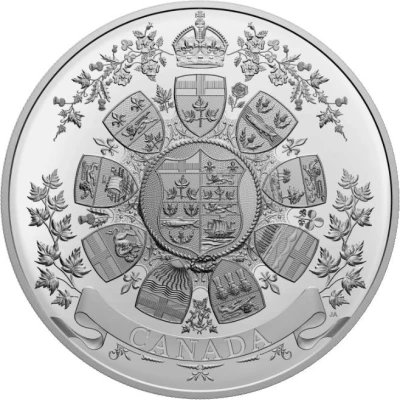

250 Dollars - Elizabeth II 1912 Heraldic Design
2021 year| Silver (.9999) | 1006 g | 102.1 mm |
| Issuer | Canada |
|---|---|
| Queen | Elizabeth II (1952-2022) |
| Type | Non-circulating coin |
| Year | 2021 |
| Value | 250 Dollars 250 CAD = USD 185 |
| Currency | Dollar (1858-date) |
| Composition | Silver (.9999) |
| Weight | 1006 g |
| Diameter | 102.1 mm |
| Shape | Round |
| Technique | Milled |
| Orientation | Medal alignment ↑↑ |
| Updated | 2024-10-04 |
| Numista | N#364881 |
|---|---|
| Rarity index | 97% |
Reverse
The reverse features an engraved reproduction of a heraldic design drawn before the Canadian Coat of Arms was proclaimed in 1921. Based on a pen-and-ink drawing by Joseph Aubé, the design depicts the quartered shield of the Dominion of Canada, surrounded by the nine provincial coats of arms that were in effect in 1912: (clockwise from top) Ontario, Nova Scotia, Prince Edward Island, Alberta, Saskatchewan, British Columbia, Manitoba, New Brunswick and Quebec. The composition is surmounted by a stylized Royal Crown and framed by the symbols of Canada, France and the United Kingdom, as well as by a banner that appears to extend to the obverse.
Script: Latin
Lettering:
CANADA
JA
Designer: Joseph Aubé
Edge
Serrated
Comment
One hundred years ago, Canada's distinctive new coat of arms was born. Before that, a multitude of heraldic emblems represented the young nation that had yet to blossom.Taken from the national archives, one of these designs comes to life on a coin struck in a kilo of fine silver. The design is inspired by a 1912 drawing of Canada's heraldic emblems. The historical style is fascinating in itself, but it's what's missing from the composition that offers us a rare glimpse into Canada's heraldic past.
A turbulent heraldic era: 1867-1921
After Confederation, Canada experienced a period of expansion that is reflected in the completely different heraldic motifs of this era. The shield of the four provinces, granted to the Dominion of Canada in 1868 to serve as the Great Seal, was often taken up by amateur artists and heralds: while some surrounded it with Canadian artistic elements, others added the emblems of each new province and territory, creating a complicated shield with up to nine quarters. Different versions appear on documents, postcards, crockery and other memorabilia; this lack of consensus led to the creation of a committee in 1919, whose mandate was to obtain a new coat of arms.
DID YOU KNOW?
If the 1912 coat of arms seems incomplete to our eyes today, it's because some familiar emblems are missing: Newfoundland joined Confederation in 1949; the coats of arms of the Yukon and Northwest Territories were approved by Her Majesty Queen Elizabeth II in 1956; and Nunavut's coat of arms was granted in 1999, the year it became Canada's youngest territory. In the original design and on this coin, Nova Scotia is represented by the coat of arms granted to it after Confederation. The 1868 shield featured a salmon on a blue band between three thistles in a gold field. However, this emblem was not popular, and was replaced in 1929 by the original coat of arms granted in 1625.
Packaging
The coin is individually encapsulated and presented in a wooden case embossed with the Royal Canadian Mint logo, accompanied by a black protective box.
Interesting fact
One interesting fact about the 2021 Canadian $250 Silver Elizabeth II (1912 Heraldic Design) coin is that it has a unique rectangular shape, unlike most coins which are round.
Price
| Date | Mintage | VG | F | VF | XF | AU | UNC |
|---|---|---|---|---|---|---|---|
| 2021 | 600 | - | - | - | - | - | - |
Values in the table are based on evaluations by sales realized on Internet platforms. They serve as an indication only for 250 Dollars - Elizabeth II (1912 Heraldic Design) 2021 coin.
